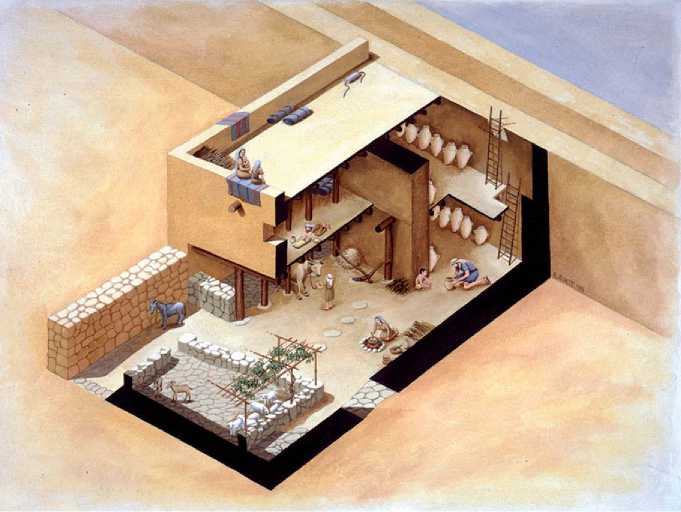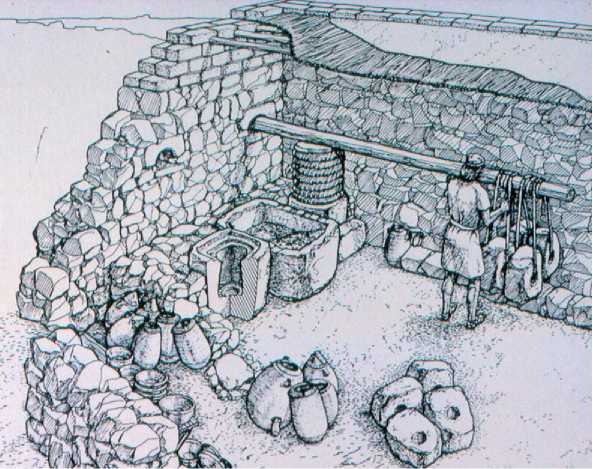Once the dust settled, it was evident that a new sociopolitical order existed: into the political vacuum had come new peoples (Neo-Hittites, Phoenicians, Arameans, Israelites, Philistines Moabites, Ammonites, Edomites). New nation kingdoms were shortly to arise in this new age of Iron, only to succumb to a sequence of world empires: Neo-Assyrian, Neo-Babylonian, Persian, and, ultimately, Alexander the Great. The LBA/IA transition remains enigmatic, as does the reconstitution of new political entities by numerous ethnic groups. What was the cultural and political impact of empire on Levantine peoples?
North (Iron I)
Three regional nation-states are recognizable: Neo-Hittites (north), Phoenicians (coast), and Arameans (previous nomads of the steppe), who controlled most of Syria, even south to Lake Galilee. Affirmed by continuity at numerous sites (Tell Afis, Carchemish, Hama), these LBA descendants reconfigured into a number of competing polities (1200-900 BCE).
Archaeologically, it is hard to sort out the multiethnic cities described in the texts, since the sometimes-overlapping Aramaean and Neo-Hittite kingdoms embrace similar elite markers. Good examples are the Aramean sites of ‘Ain Dara, whose Syrian ‘bit-hilani’ temple is adorned with Neo-Hittite carved reliefs of mythological creatures and sculpted sphinxes and lions; and Tell Halaf whose colossal caryatid statues are extraordinary. A new city plan, smaller, oval, double-walled, with citadel (Tayinat, Zincirli) is a hallmark of the period (also found at Megiddo in the south).
Phoenicians (Canaanites) These colonizers (Carthage) and traders who opened the Levant to western (Greek) culture were extremely important - quantities of Greek pottery in coastal sites like Tell Sukkas, Al Mina, Tabbat al-Hammam may equate with colonies. Their major ports are mostly modern cities today: Byblos, Sidon, Tyre, Beirut, and Arwad (Akko in the south), which limits excavation, although there are sarcophagi (Ahiram), Sidon’s temple to Eshmun, 200 inscribed funerary stelae outside Tyre, numerous inscriptions, and important pre-eighth century materials from Sarepta. They were renowned for crafts (purple cloth, masonry, glass), but especially ivories, which adorned Samaria (castigated by the prophets) and comprised the famous Nimrud (Assyria) Ivories, thought to be tribute or booty. Undoubtedly, their most lasting contribution was the linear alphabet, ancestor to the Hebrew and Greek alphabets.
Empires (Iron II)
Just before 900, the already entrenched Assyrians campaigned from the Jezireh to the coast, absorbing their enemy, the Aramaeans, in the process and their alphabetic language, Aramaic (the new lingua franca). Evidence of imperial domination is clearest in the Jezireh. There, besides ‘palace ware’, provincial centers with Assyrian wall paintings were found. Dur-Katlimmu, a huge (288 acre) walled site included a garden mural, while a famous mural of a king hunting adorned the walls at Til Barsip, a site with citadel and vast ‘bit-hilani’ palace. Colonies were also established as supply centers and/or settlements for deportees (well-known Assyrian policy). The subsequent Neo-Babylonian Empire, following the destruction of Nineveh in 609, left few imperial markers, except for their reuse of the provincial site of Dur-Katlimmu, where tablets recovered from the impressive Red House, date to Nebuchadnezzar. The Persian Empire (539-332) left few remains inland - a rectangular fort has been found at Ebla. The coast, however, thrived, since the Persians required fleets to transport their armies. There the site of Amrit - a stunning colonnaded open-air water temple - exhibits a blend of both Persian and Greek influences.
Southern Levant (Iron I)
With the first mention of a people, Israel (Merneptah Stele 1207), the archaeology of the area relates to the Bible, and questions of ‘settlement’ and ethnicity arise. There is no incontrovertible evidence for an invasion (e. g., Jericho). Conversely, continuity of LBA Canaanite tradition in hundreds of newly founded rural villages (Shiloh, ‘Ay, Raddana, Giloh) is evident in pottery, cult (Bull Site), language (Raddana, el Khadr, Izbet Sartah), along with an emergent Iron Age repertoire of four-room pillar buildings and collar-rim jars. The data suggest that in the wake of widespread LBA upheaval, probably multiethnic peoples, for example, Habiru, Shashu (Amarna), Israel (Merneptah Stele), Hittites, Amorites, etc. (Bible), settled in the highlands, eventually coalescing to form a national kingdom (Israel). A similar development is posited (LBA/IA site of Umayri with its

Figure 12 The ‘Four-room’ Iron Age I House at Tall al-‘Umayri, Jordan-Artist’s rendition by Rhonda Root. By Permission of Rhonda Root and the Madaba Plains Project-Umayri.
Four-room house (Figure 12) and collar rim jars) for the national kingdoms of Ammon, Moab, Edom. Not in question is the ethnicity of settlers on the coast: they were the Philistines, part of the Sea Peoples whose highly urbanized cities, Aegean-derived material culture, and iron technology, have been brilliantly brought to light (Ekron, Gath, Ashkelon, Ashdod, Qasile).
The United Monarchy, Tenth Century (Iron IIA)
The issue of secondary state formation (David and Solomon) is in flux, as one school reassigns well-known strata to the ninth century. Some scholars suggest that state-level societies arose only in the eighth century. Briefly, the questionable materials include: (1) four-entryway gates (Hazor, Gezer, Megiddo), (2) palaces 6000 and 7320 at Megiddo, (3) royal planned forts in the Negev (Arad, Beersheba), and (4) Jerusalem Temple parallels (‘Ain Dara). While tenth century strata are becoming better known (Tell Rehov, Tel Zayit abecedary), Jerusalem’s occupation remains controversial. There are, however, extra-biblical tenth century correlations, such as Ahiram’s sarcophagus and Pharaoh Shishak’s raid. The picture is clearer from the beginning of the ninth century with the Divided Kingdom.
The Northern Kingdom (Iron IIB)
The well-fortified ninth and eighth century cities of Israel suggest a powerful, but embattled nation state.
Stelae record victories of Aramaeans (Dan Stele, which also mentions the house of David), Moabites (Mesha Stele), and Assyrians (Black Obelisk showing King Jehu bowing and giving tribute). Tell Dan’s exceptional cultic precinct confirms the breakaway kingdom of Jeroboam in the Bible. Royal building activities depict a powerful state, for example, Ahab’s monumental pillared buildings (‘chariot cities’) or storerooms (Hazor, Beersheva), water systems (Hazor, Gezer, Megiddo), but especially the lavish Phoenician style palace at Samaria. Destruction of the latter by the Assyrians in 722/721 brought the northern kingdom to an end, its people deported.
The Transjordanian kingdoms, more cordial client states, survived the depredations of the Assyrians. Iron II sites are well-fortified (Tell es-Sa‘idiyeh, Tell Deir ‘Alla, Tell Mazar, Dibon, Lehun, Mudayna, ‘Umayri, Jalul, Tawila, Buseirah, Umm el-Biyara, Tell el-Kheleifeh), but the term ‘tribal kingdoms’ is increasingly used to describe these polities. A fascinating local tradition is seen in a group of statues of Ammonite kings.
The Southern Kingdom (Iron IIC)
In the ninth to eighth centuries, nation-states in both north and south are demonstrable by a four-tier hierarchical settlement: royal capitals (Jerusalem, Samaria), administrative centers (Lachish), smaller centers (Beersheba), and provincial towns (Tell Beit

Figure 13 Tel Miqne, Israel, reconstruction of an olive oil manufacturing facility, seventh c. BCE. © Tell Miqne-Ekron Excavation Project, courtesy S. Gitin; drawing: E. Cohen.
Mirsim). Jerusalem’s expansion and strengthening (Hezekiah’s ‘broad’ wall and tunnel) is confirmed. The remains of the 701 Assyrian siege of Lachish, including the siege ramp, is a stark reminder of life under empire, and is commemorated in Sennacherib’s relief at Nineveh. Elsewhere, the Philistine site of Ekron (Tell Miqne) functioned as an Assyrian supply center and became the largest olive oil production center in the Near East (Figure 13). A major area of current Iron II research centers on ‘popular religion’. A vast corpus of cult sites (Arad, Tell el-Far‘ah (N), Taanach, Kuntillet ‘Ajrud, the Edomite sites Hurvat Qitmit and Hurvat ‘Uza), and female figurines (‘Asherah’), provide tantalizing clues about the range of Israelite practices, set in a context of the wider world of Near Eastern religion. The Neo-Babylonian destruction (587/6 BCE) of Jerusalem has vividly come to light (Ahilu’s house). Ultimately (539 BCE), Cyrus the Great of Persia allowed the deported Jews in Babylon to return home.
Persian Period (Iron III)
New research demonstrates site continuity, despite devastation and exile. The archaeology of Jerusalem confirms a much-reduced city, as exiles returned from Babylon and rebuilt, and minted coins refer to the province as Yehud. Provincial garrison towns at Hesi, Jemmeh, Khirbet Abu Tuwein, Tell es-Sa‘idiyeh, and material culture, affirm imperial control. The interior of the country, generally, contrasts with the Phoenician coast, where sites (Dor, Akko, Ashdod, Askhelon) thrived due to Persian trade. Luxury items and Attic ware underscore prosperity under empire and intensifying Greek cultural influence.




 World History
World History









